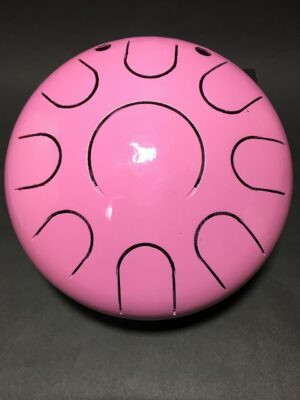Deep overtones are ideal for meditation and yoga
“Dual-layered tongues tuned in octaves for a rich harmonic bloom.”
The drum in the video has a diameter of 22 cm, but this model is mainly made with a diameter of 25 cm
The sound of the Propanota drifts gently into the air, like ripples across a still lake.
It speaks with the softness of wind rustling through trees—
a quiet voice that resonates deep within, if you simply stop and listen.

プロパノータの音は、静かな湖面に広がるさざ波のように、そっと空気中へと溶け込んでいきます。
それは風に揺れる木々のような優しいささやきで、
ただ耳を澄ますだけで、心の奥深くにまで届く声となります。
product code ⇒ |
P12 (12 notes ) |
P15 ( 15 notes ) |
Price |
$380 |
$420 |
| Diameter | 25cm | |
| height | 18cm | |
| weight, accessories | 2,8kg | |
| accessories |
mallet x 2 / tuning magnet x 6 / swimming cap / output jack |
|
Key変更に別途料金は掛かりません。
Key changes are free
If the key of the instrument is high, the overall impression will be bright and sparkling. Conversely, if the key is low, the impression will be calm.
Setting the instrument’s key to “F” or “G” will give the impression that the notes resonate well from high to low.
Keyが高ければ「キラキラ」とした明るい印象の音になります。
低めで落ち着いた感じでしたらKeyは「C(ド)」、「D(レ)」がお勧めです。
Key「F(ファ)」「G(ソ)」は低~高までバランスよく響きます。
基本の音階は「琉球音階」ですが、すべて付属のチューニング用マグネットにより「メジャー音階」「マイナー音階」に移行可能です。
The basic scale is the “Ryukyu scale,” but it can be switched to the “major scale” or “minor scale” using the included tuning magnet.
| Key | Constituent Tones | |||||
| C | C | E | F | G | B | C |
| D | D | F# | G | A | C# | D |
| E | E | G# | A | B | D# | E |
| F | F | A | Bb | C | E | F |
| G | G | B | C | D | F# | G |
| A | A | C# | D | E | G# | A |
| B | B | D# | E | F# | A# | B |
Key変更に別途料金は掛かりません。
Key changes are free
If the key of the instrument is high, the overall impression will be bright and sparkling. Conversely, if the key is low, the impression will be calm.
Setting the instrument’s key to “F” or “G” will give the impression that the notes resonate well from high to low.
Keyが高ければ「キラキラ」とした明るい印象の音になります。
低めで落ち着いた感じでしたらKeyは「C(ド)」、「D(レ)」がお勧めです。
Key「F(ファ)」「G(ソ)」は低~高までバランスよく響きます。
基本の音階は「琉球音階」ですが、すべて付属のチューニング用マグネットにより「メジャー音階」「マイナー音階」に移行可能です。
The basic scale is the “Ryukyu scale,” but it can be switched to the “major scale” or “minor scale” using the included tuning magnet.
| Key | Constituent Tones | |||||
| C | C | E | F | G | B | C |
| D | D | F# | G | A | C# | D |
| E | E | G# | A | B | D# | E |
| F | F | A | Bb | C | E | F |
| G | G | B | C | D | F# | G |
| A | A | C# | D | E | G# | A |
| B | B | D# | E | F# | A# | B |
The basic scale is set to the “Ryukyu scale” because it can be easily switched to the “major scale” and “minor scale” using the included tuning magnet (each position is marked).
Tuning magnets can only lower the tone.
To switch to a major scale, attach magnets in three places: ②, ③, and ⑤.
To switch to a minor scale, attach magnets in two places: ② and ⑤.
If the base scale is Ryukyu, you can lower the tone to other scales, but if the base scale is the major scale, you cannot change “D” to “E”.
In this way, if the base scale is Ryukyu, other scales can be used.
Another big reason is that the tone of the propanota matches very well with the tropical atmosphere of the Ryukyu scale.
One magnet can lower the tone by “1 to 1 and a half tones”.
You can also create your own scale by attaching magnets in any position you like.
| Key |
Constituent Tones | |||||
| ① | ② | ③ | ④ | ⑤ | ⑥ | |
| C | C | E | F | G | B | C |
| D | D | F# | G | A | C# | D |
| E | E | G# | A | B | D# | E |
| F | F | A | Bb | C | E | F |
| G | G | B | C | D | F# | G |
| A | A | C# | D | E | G# | A |
| B | B | D# | E | F# | A# | B |
基本音階を「琉球音階」に設定すると、付属のチューニング用磁石で「メジャー音階」「マイナー音階」へ簡単に移行可能だからです(それぞれの位置に印が付いています)。
チューニング用磁石では音を低くすることしか出来ません。
赤字の音が磁石によって低くなる音です。
琉球が基本になっていれば他の音階の音へ、音を低くすることが出来ますが、仮に「メジャー音階」を基本にした場合、「レ」を「ミ」に変更することは出来ません。
このように、基本音階が琉球であれば他の音階も利用可能ということになるからです。
加えてプロパノータの音色と南国情緒あふれる琉球音階の雰囲気がとてもマッチするということも大きな理由の一つになります。
ひとつの磁石で「1音~1音半」音を低くすることが出来ます。
好きな位置に磁石を付けてあなただけの音階を生み出すことも可能です。
焼き色茶系(クリア仕上げ)
黒さび加工
素材色(クリア仕上げ)
焼き色青系(クリア仕上げ)
エメラルド
キャンディブルー
オレンジ
イエロー
渦巻き(プラス2000円)
地色塗装後、渦巻き模様を入れクリア仕上げを施し模様を保護します。
(地色、クリア塗装は粉体塗装をします)
水流
墨流し
チョコミント
マーブル模様(プラス2000円)
A resonating sound can be added to the bottom or inside so that it resonates with the surface sound plate.
By slightly shifting the frequency of the two sounds, it is possible to “give the sound fluctuations.”
In instruments used in orchestras, this is called a “groaning sound” and is avoided.
However, in this metal tongue drum, this combined with the characteristics of the sound creates a healing effect that is quite sufficient.
◎アウトプットジャック取り付け⇒¥3,000
◎底面共鳴音追加⇒¥1,000(1音につき)共鳴音を入れると音が「フワァワァン」というように揺らいだ感じになります。
◎音板丸型加工⇒¥3,000(全体で)

